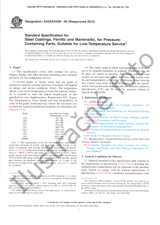Potrebujeme váš súhlas na využitie jednotlivých dát, aby sa vám okrem iného mohli ukazovať informácie týkajúce sa vašich záujmov. Súhlas udelíte kliknutím na tlačidlo „OK“.
ASTM D8458-22
Standard Test Method for Evaluation of Fatigue Performance of Asphalt Mixtures Using the Three-Point Bending Cylinder (3PBC) Test
NORMA vydaná dňa 15.12.2022
Informácie o norme:
Označenie normy: ASTM D8458-22
Dátum vydania normy: 15.12.2022
Kód tovaru: NS-1098660
Počet strán: 12
Približná hmotnosť: 36 g (0.08 libier)
Krajina: Americká technická norma
Kategória: Technické normy ASTM
Anotácia textu normy ASTM D8458-22 :
Keywords:
asphalt concrete dynamic modulus, asphalt concrete fatigue, asphalt concrete tensile testing, fatigue life, flexural bending, shear bending, Timoshenko beam theory,
Doplňujúce informácie
| Significance and Use |
|
5.1?This test method can be utilized to determine the fatigue resistance of asphalt mixtures. The test method is generally valid for specimens that are tested at intermediate temperatures. The three-point bending cylinder test samples are obtained by coring a 68 mm diameter cylinder from the center of a 150 mm diameter gyratory compacted sample, or horizontal coring from field cores or slabs cut from field sections. After coring, the sample is ready for testing and no further sample preparations steps are required. The two ends of the 68 mm diameter three-point bending cylinder sample do not need to be sliced. 5.2?The Timoshenko beam theory is used to calculate the reduction in dynamic modulus for each loading cycle. The test can be used to investigate the fatigue behavior of asphalt mixtures at various strain levels, temperatures, and frequencies. The results can be used to compare the fatigue life (Nf) for different asphalt mixtures. The NNote 1:?The quality of the results produced by this test method are dependent on the competence of the personnel performing the procedure and the capability, calibration, and maintenance of the equipment used. Agencies that meet the criteria of Specification D3666 are generally considered capable of competent and objective testing, sampling, inspection, etc. Users of this test method are cautioned that compliance with Specification D3666 alone does not completely ensure reliable results. Reliable results may depend on many factors; following the suggestions of Specification D3666 or some similar acceptable guideline provides a means of evaluating and controlling some of those factors. |
| 1. Scope |
|
1.1?This test method provides a procedure to determine the fatigue life (number of cycles to failure, Nf) of asphalt mixtures, and also the reduction in dynamic modulus (|E*|) with loading cycles, using cylindrical samples subjected to three-point cyclic bending. The results obtained from this test can be used to calibrate Viscoelastic Continuum Damage (VECD) models to obtain a damage characteristic curve, which in turn can be used to obtain fatigue lives (N1.2?The test method describes the testing apparatus, instrumentation, specimen fabrication, and analysis procedures required to determine the number of cycles to failure of asphalt concrete. 1.3?The text of this test method references notes and footnotes which provide explanatory material. These notes and footnotes (excluding those in tables and figures) shall not be considered as requirements of the test method. 1.4?UnitsThe values stated in SI units are to be regarded as the standard. No other units of measurement are included in this standard. 1.5?This standard does not purport to address all of the safety concerns, if any, associated with its use. It is the responsibility of the user of this standard to establish appropriate safety, health, and environmental practices and determine the applicability of regulatory limitations prior to use. 1.6?This international standard was developed in accordance with internationally recognized principles on standardization established in the Decision on Principles for the Development of International Standards, Guides and Recommendations issued by the World Trade Organization Technical Barriers to Trade (TBT) Committee. |
Odporúčame:
Aktualizácia technických noriem
Chcete mať istotu, že používate len platné technické normy?
Ponúkame Vám riešenie, ktoré Vám zaistí mesačný prehľad o aktuálnosti noriem, ktoré používate.
Chcete vedieť viac informácií ? Pozrite sa na túto stránku.




 Cookies
Cookies
